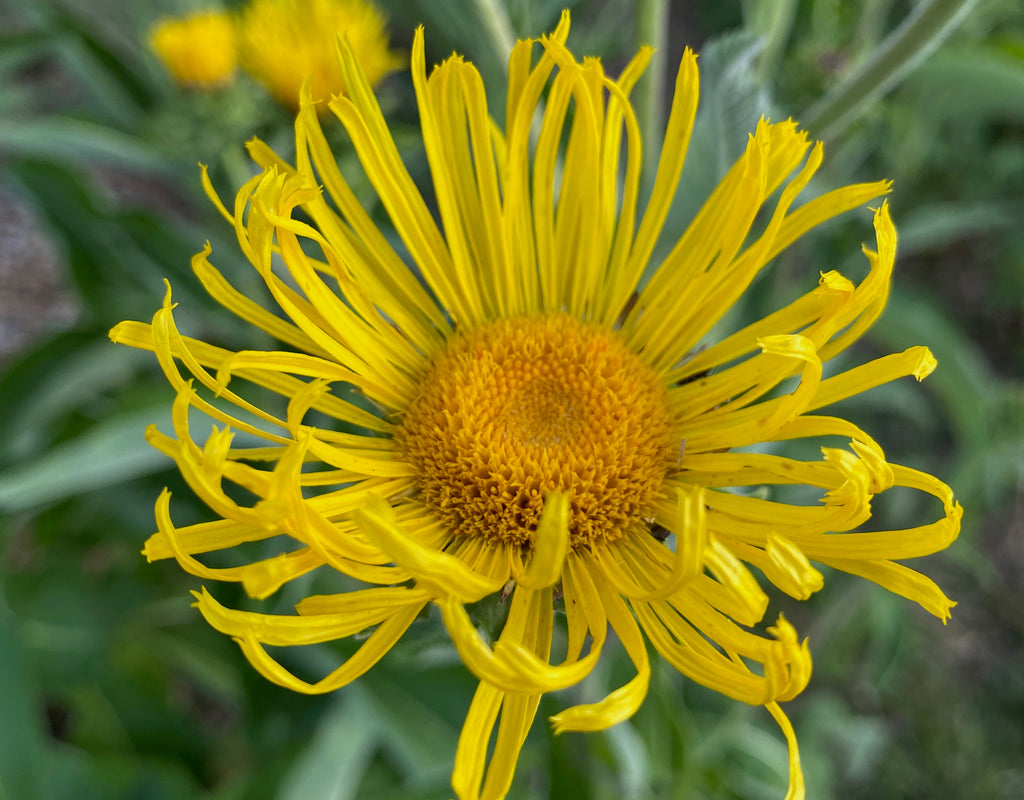A couple weeks ago I came down with a seasonal cold. I was congested and kind of miserable. Sometimes it is hard for me to remember my herbal allies when I am not feeling well but this time it was easy. Elecampane has been one of my favorite sick time herbs since I started studying herbal medicine. I’ve always found it to be really effective and I love growing it in my garden. This herb might be just what you need right now too, so I thought I would write about it today.
Elecampane is a perennial herb in the Asteraceae family, a truly vast plant family. It includes some favorites like Artichokes, Calendula, Cosmos, Sunflowers and Echinaea. Altogether there are around 32,000 species that we know of in the Aster family. The latin name for Elecampane is Inula helenium. There are other species in the Inula genus, but this is the one I am most familiar with. Elecampane grows in the United States but is not native here. It grows wild in Egypt and around the Mediterranean, as well as in Asia and Russia (1). Generally, Elecampane grows best in moist and partially shaded areas and will do well in most garden soil. It is always nice to have plants that prefer the places some others can not tolerate.
One of the common names for Elecampane, Wild Sunflower, points to its Aster relative. It is really beautiful and shares characteristics with Sunflowers like downy leaves and long tall stout stems. You will want to give this beauty a lot of space in the garden because it can grow quite large. It will continue to spread rhizomatically in subsequent years.The leaves form close to the ground and then the stem sprouts upwards, it can end up at least 5 feet tall. The pretty yellow flowers will not appear until the second year.

Illustration courtesy of https://www.biodiversitylibrary.org/page/49428864#page/516/mode/1up
Propagation can be done by seed or by cutting. Cuttings are generally a faster way to get a large plant but all cuttings are clones of the parent plant. I prefer to grow things from seed because it keeps the genetic diversity alive. Cloning plants can lead to issues with disease as well but sometimes it is nice to know you will have an exact copy of the plant you want. The seeds are quite small and should be pressed into the top of the soil, then gently rake a little soil over them or cover with vermiculite. Seeds take between 14-21 days to germinate. They can be direct sown into the garden but since they take awhile to germinate it might be easier to start them in potting soil. For more information about germinating our herb seeds check out our Germination Guide. Elecampane seeds are pretty easy to collect on your own and are ready in the late summer.
According to A Modern Herbal by Maude Grieve, “For pharmaceutical use, the root is taken from plants two to three years old, when more advanced it becomes woody.” I was taught by nearly all of my herb teachers that fall was the best time to harvest roots because the constituents concentrate in the root when the photosynthesizing part of the plant dies. The root is the part that is used in herbal medicine. Dig the roots up in the fall. You do not have to dig up the whole plant, digging some of the roots will allow the plant to grow back the following year. Process the roots when they are wet, it becomes much more difficult to cut after the root dries. I usually chop the root into small pieces and then dry it in my dehydrator.
A lot of scholarly articles and academic studies can be found on the medicinal efficacy of Elecampane. In an article Elecampane and Job’s Disease, the author mentions the uses described by Hippocrates, “a good stimulant for the brain, stomach and spleen. Also, relieves cough and asthma and rheumatic pains…” (2) Most often when I turn to Elecampane it is for respiratory symptom relief. According, to Maude Grieve ,“In herbal medicine it is chiefly used for coughs, consumption and other pulmonary complaints, being a favorite domestic remedy for bronchitis.” (3) Maude Grieve wrote her book on herbal medicine quite a long time ago but a lot of what she writes rings true today. There is a recent and very cool study from Ireland which determined that in-vitro Elecampane demonstrated anti-staphylococcal properties, in line with traditional use (4). I will not go any further into Elecampane’s uses or its constituents but if you are curious there's a lot of information out there about it.
There are many ways to prepare Elecampane. You can make tea with the dried root or tincture it, the root can be powdered and also infused into oil for topical uses. I really enjoy candied Elecampane especially when I am not feeling well. One method to make candied Elecampane is to slice the fresh root very thin and then dip it in honey. Lay the honey dipped roots on to a lined dehydrator tray and then dehydrate at 110 degrees or so for 6-8 hours. Check them a couple times while they are drying for consistency.Then put the dried slices into a jar before you are ready to use them. They are pretty shelf stable dipped in honey but you probably want to stick them in the fridge to be on the safe side. Then, I nibble on one of the slices if I have a cough. They are bitter and sweet and aromatic. I really love the flavor.
References


jessica
Thanks for he recipe and the uses. Great Plant!